Improvement of Physical and Electrical Characteristics in 4H-SiC MOS Capacitors Using AlON Thin Films Fabricated via Plasma-Enhanced Atomic Layer Deposition
Abstract
1. Introduction
2. Experimental Methods
2.1. Fabrication
2.2. Characterization
3. Results and Discussion
3.1. Quality of AlON Films
3.2. AlON/SiC Interface Properties
3.3. Electrical Properties of AlON/SiC MOS Capacitor
4. Conclusions
Author Contributions
Funding
Data Availability Statement
Conflicts of Interest
Abbreviations
| SiC | Silicon Carbide |
| Si | Silicon |
| PEALD | Plasma-Enhanced Atomic Layer Deposition |
| RF | Radio Frequency |
| AlN | Aluminum Nitride |
| Al2O3 | Aluminum Oxide |
| AlON | Aluminum Oxynitride |
| TMA | Trimethylaluminum |
| BOE | Buffered Oxide Etch |
| AFM | Atomic Force Microscopy |
| XRD | X-ray Diffraction |
| XPS | X-ray Photoelectron Spectroscopy |
| SE | Ellipsometry |
| NITs | Near-Interface Traps |
| Neff | Effective Fixed Charge Density |
| Dit | Interface State Density |
| I-V | Current–Voltage |
| C-V | Capacitance–Voltage |
| FN | Fowler–Nordheim |
| ΔEV | Valence Band Offset |
| ΔEC | Conduction Band Offset |
| VBM | Valence Band Maxima |
| J | Current Density |
| J-E | Current Electric Field |
| VG | Gate Voltage |
References
- Amini Moghadam, H.; Dimitrijev, S.; Han, J.; Haasmann, D. Active defects in MOS devices on 4H-SiC: A critical review. Microelectron. Reliab. 2016, 60, 1–9. [Google Scholar] [CrossRef]
- Yano, H.; Hirao, T.; Kimoto, T.; Matsunami, H.; Shiomi, H. Interface properties in metal-oxide-semiconductor structures on n-type 4H-SiC(033). Appl. Phys. Lett. 2002, 81, 4772–4774. [Google Scholar] [CrossRef]
- Hedayati, R.; Zetterling, C.-M. Material aspects of wide temperature range amplifier design in SiC bipolar technologies. J. Mater. Res. 2016, 31, 2928–2935. [Google Scholar] [CrossRef]
- Lipkin, L.A.; Palmour, J.W. Insulator investigation on SiC for improved reliability. IEEE Trans. Electron Devices 1999, 46, 525–532. [Google Scholar] [CrossRef]
- Fiorenza, P.; Vivona, M.; Di Franco, S.; Smecca, E.; Sanzaro, S.; Alberti, A.; Saggio, M.; Roccaforte, F. Properties of Al2O3 thin films deposited on 4H-SiC by reactive ion sputtering. Mater. Sci. Semicond. Process. 2019, 93, 290–294. [Google Scholar] [CrossRef]
- Wright, N.G.; Poolamai, N.; Vassilevski, K.; Horsfall, A.B.; Johnson, C.M. Benefits of high-k dielectrics in 4H-SiC trench MOSFETs. Mater. Sci. Forum 2004, 457, 1433–1436. [Google Scholar] [CrossRef]
- Mogniotte, J.F.; Raynaud, C.; Lazar, M.; Allard, B.; Planson, D. SiC lateral Schottky diode technology for integrated smart power converter. In Proceedings of the 2018 IEEE International Conference on Industrial Technology (ICIT), Lyon, France, 20–22 February 2018; pp. 841–846. [Google Scholar] [CrossRef]
- Siddiqui, A.; Khosa, R.Y.; Usman, M. High-k dielectrics for 4H-silicon carbide: Present status and future perspectives. J. Mater. Chem. C 2021, 9, 5055–5081. [Google Scholar] [CrossRef]
- Khosa, R.Y.; Thorsteinsson, E.B.; Winters, M.; Rorsman, N.; Karhu, R.; Hassan, J.; Sveinbjornsson, E.O. Electrical characterization of amorphous Al2O3 dielectric films on n-type 4H-SiC. Aip Adv. 2018, 8, 025304. [Google Scholar] [CrossRef]
- Guo, Y.D.; Wang, A.F.; Huang, Q.M.; Wang, Z.Y.; Ma, H.P.; Zhang, Q.C. Performance Comparison of Al2O3 Gate Dielectric Grown on 4H-SiC Substrates via Thermal and Plasma-Enhanced Atomic Layer Deposition Methods. ECS J. Solid State Sci. Technol. 2025, 14, 023005. [Google Scholar] [CrossRef]
- Tanner, C.M.; Perng, Y.-C.; Frewin, C.; Saddow, S.E.; Chang, J.P. Electrical performance of Al2O3 gate dielectric films deposited by atomic layer deposition on 4H-SiC. Appl. Phys. Lett. 2007, 91, 203510. [Google Scholar] [CrossRef]
- Galizia, B.; Fiorenza, P.; Schilirò, E.; Pecz, B.; Foragassy, Z.; Greco, G.; Saggio, M.; Cascino, S.; Lo Nigro, R.; Roccaforte, F. Towards aluminum oxide/aluminum nitride insulating stacks on 4H–SiC by atomic layer deposition. Mater. Sci. Semicond. Process. 2024, 174, 108244. [Google Scholar] [CrossRef]
- Xia, J.; Wang, S.; Tian, L.; Zhang, W.; Xu, H.; Wan, J.; Wan, C.; Pan, Y.; Yang, F. Al(ON) gate dielectrics for 4H-SiC MOS devices. J. Cryst. Growth 2020, 532, 125434. [Google Scholar] [CrossRef]
- Zhu, X.G.; Shen, Z.W.; Wang, Z.J.; Liu, Z.R.; Miao, Y.Y.; Yue, S.Z.; Fu, Z.; Li, Z.H.; Zhang, Y.N.; Hong, R.D.; et al. Effects of gamma-ray irradiation on material and electrical properties of AlN gate dielectric on 4H-SiC. Nanotechnology 2024, 35, 275704. [Google Scholar] [CrossRef] [PubMed]
- Guo, Y.-D.; Wang, A.-F.; Huang, Q.-M.; Wang, Z.-Y.; Ma, H.-P.; Zhang, Q.-C. Interfacial and electrical characterizations of PEALD-grown AlN/4H-SiC MOS structure: A type-I heterojunction for enhanced blocking performance. J. Mater. Sci. Mater. Electron. 2025, 36, 210. [Google Scholar] [CrossRef]
- Takeuchi, W.; Yamamoto, K.; Sakashita, M.; Nakatsuka, O.; Zaima, S. Effect of N bonding structure in AlON deposited by plasma-assisted atomic layer deposition on electrical properties of 4H-SiC MOS capacitor. Jpn. J. Appl. Phys. 2018, 57, 01AE06. [Google Scholar] [CrossRef]
- Hosoi, T.; Azumo, S.; Kashiwagi, Y.; Hosaka, S.; Yamamoto, K.; Aketa, M.; Asahara, H.; Nakamura, T.; Kimoto, T.; Shimura, T.; et al. Comprehensive and systematic design of metal/high-k gate stack for high-performance and highly reliable SiC power MOSFET. Jpn. J. Appl. Phys. 2020, 59, 021001. [Google Scholar] [CrossRef]
- Chen, H.-Y.; Lu, H.-L.; Chen, J.-X.; Zhang, F.; Ji, X.-M.; Liu, W.-J.; Yang, X.-F.; Zhang, D.W. Low-Temperature One-Step Growth of AlON Thin Films with Homogenous Nitrogen-Doping Profile by Plasma-Enhanced Atomic Layer Deposition. ACS Appl. Mater. Interfaces 2017, 9, 38662–38669. [Google Scholar] [CrossRef]
- Alevli, M.; Ozgit, C.; Donmez, I.; Biyikli, N. The influence of N2/H2 and ammonia N source materials on optical and structural properties of AlN films grown by plasma enhanced atomic layer deposition. J. Cryst. Growth 2011, 335, 51–57. [Google Scholar] [CrossRef]
- Blochl, P.E. Projector augmented-wave method. Phys. Rev. B 1994, 50, 17953–17979. [Google Scholar] [CrossRef]
- Usman, M.; Hallén, A.; Pilvi, T.; Schöner, A.; Leskelä, M. Toward the Understanding of Stacked Al-Based High-k Dielectrics for Passivation of 4H-SiC Devices. J. Electrochem. Soc. 2011, 158, H75–H79. [Google Scholar] [CrossRef]
- Van Bui, H.; Wiggers, F.B.; Gupta, A.; Nguyen, M.D.; Aarnink, A.A.I.; de Jong, M.P.; Kovalgin, A.Y. Initial growth, refractive index, and crystallinity of thermal and plasma-enhanced atomic layer deposition AlN films. J. Vac. Sci. Technol. A 2015, 33, 01A111. [Google Scholar] [CrossRef]
- Giba, A.E.; Pigeat, P.; Bruyère, S.; Easwarakhanthan, T.; Mücklich, F.; Horwat, D. Controlling refractive index in AlN films by texture and crystallinity manipulation. Thin Solid Film. 2017, 636, 537–545. [Google Scholar] [CrossRef]
- Ishchenko, A.V.; Akhmadullina, N.S.; Leonidov, I.I.; Sirotinkin, V.P.; Skvortsova, L.G.; Shishilov, O.N.; Zhidkov, I.S.; Kukharenko, A.I.; Kargin, Y.F. Synthesis and spectroscopic properties of aluminum oxynitride doped with 3d-metal ions: The case of γ-AlON:Ti. J. Alloys Compd. 2023, 934, 167792. [Google Scholar] [CrossRef]
- Zhang, X.; Li, Z.; Zeng, Q. First-principles calculation on the electronic structure and optical properties of Eu2+ doped γ-AlON phosphor. Ceram. Int. 2018, 44, 1461–1466. [Google Scholar] [CrossRef]
- Gu, L.; Ma, H.-P.; Li, Y.; Wang, A.-F.; Chen, W.-J.; Tang, Z.-R.; Shen, Y.; Sun, F.y.; Zhu, J.-T.; Zhang, Q.-C. Investigation of gallium oxide thin film hetero-integrated with bulk diamond via atomic layer deposition. Appl. Surf. Sci. 2023, 641, 158502. [Google Scholar] [CrossRef]
- Nguyen, T.T.; Jung, D.H.; Lee, J.J.; Lee, H. Optical study of Ga2-xSnxO3 (0 ≤ x ≤ 0.7) thin films using spectroscopic ellipsometry and cathodoluminescence. Thin Solid Film. 2023, 764, 139611. [Google Scholar] [CrossRef]
- Ababneh, A.; Schmid, U.; Hernando, J.; Sánchez-Rojas, J.L.; Seidel, H. The influence of sputter deposition parameters on piezoelectric and mechanical properties of AlN thin films. Mater. Sci. Eng. B-Adv. Funct. Solid-State Mater. 2010, 172, 253–258. [Google Scholar] [CrossRef]
- Kuo, M.C.; Tsai, C.M.; Huang, J.C.; Chen, M. PEEK composites reinforced by nano-sized SiO2 and Al2O3 particulates. Mater. Chem. Phys. 2005, 90, 185–195. [Google Scholar] [CrossRef]
- Yin, J.; Chen, D.; Yang, H.; Liu, Y.; Talwar, D.N.; He, T.; Ferguson, I.T.; He, K.; Wan, L.; Feng, Z.C. Comparative spectroscopic studies of MOCVD grown AlN films on Al2O3 and 6H–SiC. J. Alloys Compd. 2021, 857, 157487. [Google Scholar] [CrossRef]
- Komatsu, N.; Masumoto, K.; Aoki, H.; Kimura, C.; Sugino, T. Characterization of Si-added aluminum oxide (AlSiO) films for power devices. Appl. Surf. Sci. 2010, 256, 1803–1806. [Google Scholar] [CrossRef]
- Chen, J.; Lv, B.; Zhang, F.; Wang, Y.; Liu, X.; Yan, G.; Shen, Z.; Wen, Z.; Wang, L.; Zhao, W.; et al. The composition and interfacial properties of annealed AlN films deposited on 4H-SiC by atomic layer deposition. Mater. Sci. Semicond. Process. 2019, 94, 107–115. [Google Scholar] [CrossRef]
- Jung, S.-B.; Park, H.-H.; Kim, H. Investigation of the bonding states of the SiO2 aerogel film/metal interface. Thin Solid Film. 2004, 447–448, 575–579. [Google Scholar] [CrossRef]
- Shen, Z.; Zhang, F.; Chen, J.; Fu, Z.; Liu, X.; Yan, G.; Lv, B.; Wang, Y.; Wang, L.; Zhao, W.; et al. Effects of annealing on the interfacial properties and energy-band alignment of AlN dielectric on 4H–SiC. Appl. Phys. Lett. 2020, 117, 102105. [Google Scholar] [CrossRef]
- Huang, L.; Tao, H.; Ma, Y.; Gu, X. A barrier model for metal-SiC contact system. Superlattices Microstruct. 2020, 140, 106475. [Google Scholar] [CrossRef]
- Kraut, E.A.; Grant, R.W.; Waldrop, J.R.; Kowalczyk, S.P. Precise Determination of the Valence-Band Edge in X-Ray Photoemission Spectra: Application to Measurement of Semiconductor Interface Potentials. Phys. Rev. Lett. 1980, 44, 1620–1623. [Google Scholar] [CrossRef]
- Robertson, J. Band offsets of wide-band-gap oxides and implications for future electronic devices. J. Vac. Sci. Technol. B Microelectron. Nanometer Struct. Process. Meas. Phenom. 2000, 18, 1785–1791. [Google Scholar] [CrossRef]
- Robertson, J. Band offsets, Schottky barrier heights, and their effects on electronic devices. J. Vac. Sci. Technol. A 2013, 31, 050821. [Google Scholar] [CrossRef]
- Berens, J.; Pobegen, G.; Rescher, G.; Aichinger, T.; Grasser, T. NH3 and NO + NH3 Annealing of 4H-SiC Trench MOSFETs: Device Performance and Reliability. IEEE Trans. Electron Devices 2019, 66, 4692–4697. [Google Scholar] [CrossRef]
- Lu, W.; Wan, C.; Ge, N.; Ye, T.; Xu, H. The effects of stress on interfacial properties and flatband voltage instability of 4H-SiC MOS structures. Microelectron. Reliab. 2023, 147, 115041. [Google Scholar] [CrossRef]
- Terman, L.M. An investigation of surface states at a silicon/silicon oxide interface employing metal-oxide-silicon diodes. Solid-State Electron. 1962, 5, 285–299. [Google Scholar] [CrossRef]
- Castagné, R.; Vapaille, A. Description of the SiO2 Si interface properties by means of very low frequency MOS capacitance measurements. Surf. Sci. 1971, 28, 157–193. [Google Scholar] [CrossRef]
- Berberich, S.; Godignon, P.; Locatelli, M.L.; Millán, J.; Hartnagel, H.L. High frequency CV measurements of SiC MOS capacitors. Solid-State Electron. 1998, 42, 915–920. [Google Scholar] [CrossRef]
- Krieger, M.; Beljakowa, S.; Zippelius, B.; Afanas’ev, V.V.; Bauer, A.J.; Nanen, Y.; Kimoto, T.; Pensl, G. Detection and Electrical Characterization of Defects at the SiO2/4H-SiC Interface. Mater. Sci. Forum 2009, 645–648, 463–468. [Google Scholar] [CrossRef]
- Maity, N.P.; Kumar, A.; Maity, R.; Baishya, S. Analysis of Flatband Voltage for MOS Devices Using High-K Dielectric Materials. Procedia Mater. Sci. 2014, 5, 1198–1204. [Google Scholar] [CrossRef]
- Fowler, R.H.; Nordheim, L. Electron emission in intense electric fields. Nippon Sugaku-Buturigakkwaishi 1928, 119, 173–181. [Google Scholar] [CrossRef]
- Khosa, R.Y.; Chen, J.T.; Palsson, K.; Karhu, R.; Hassan, J.; Rorsman, N.; Sveinbjornsson, E.O. Electrical properties of 4H-SiC MIS capacitors with AlN gate dielectric grown by MOCVD. Solid-State Electron. 2019, 153, 52–58. [Google Scholar] [CrossRef]
- Huang, Q.; Guo, Y.; Wang, A.; Bai, Z.; Gu, L.; Wang, Z.; Ding, C.; Shen, Y.; Ma, H.; Zhang, Q. Study of ZrO2 Gate Dielectric with Thin SiO2 Interfacial Layer in 4H-SiC Trench MOS Capacitors. Materials 2025, 18, 1741. [Google Scholar] [CrossRef]
- Wang, X.-R.; Zeng, Y.-X.; Zhang, J.; Huang, W.; Ma, H.-P.; Zhang, Q.-C. Electronic properties of ZrO2 films fabricated via atomic layer deposition on 4H-SiC and Si substrates. Mater. Res. Express 2024, 11, 015902. [Google Scholar] [CrossRef]
- Kwon, S.; Kim, D.-K.; Cho, M.-H.; Chung, K.-B. Reduction of defect states in atomic-layered HfO2 film on SiC substrate using post-nitridation annealing. Thin Solid Film. 2018, 645, 102–107. [Google Scholar] [CrossRef]
- Xu, D.; Zheng, L.; Cheng, X.; Wang, G.; Wang, Q.; Xin, W.; Ye, P.; Shen, L.; Yu, Y. Band alignment regulation of HfO2/SiC heterojunctions induced by PEALD with in situ NH3-plasma passivation. Phys. Lett. A 2019, 383, 3134–3137. [Google Scholar] [CrossRef]
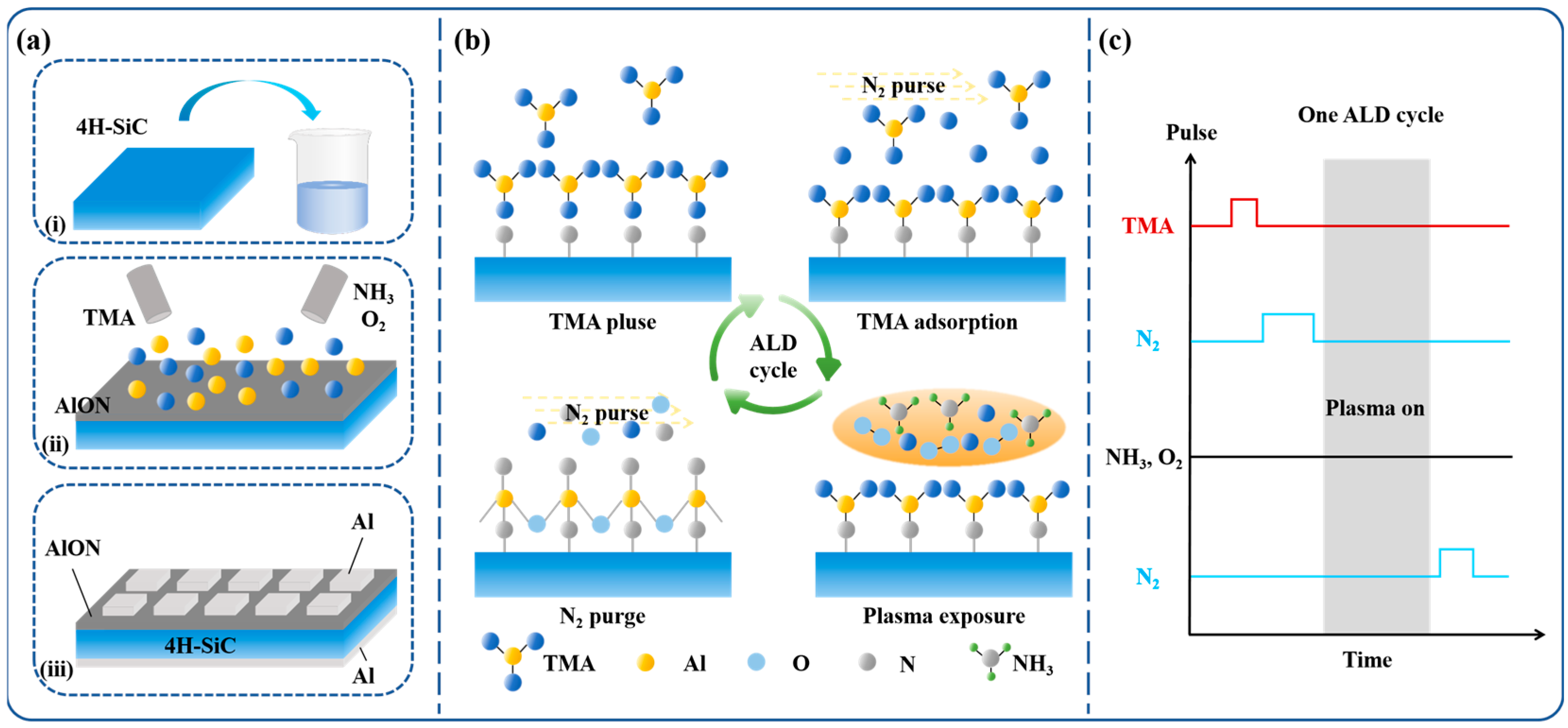
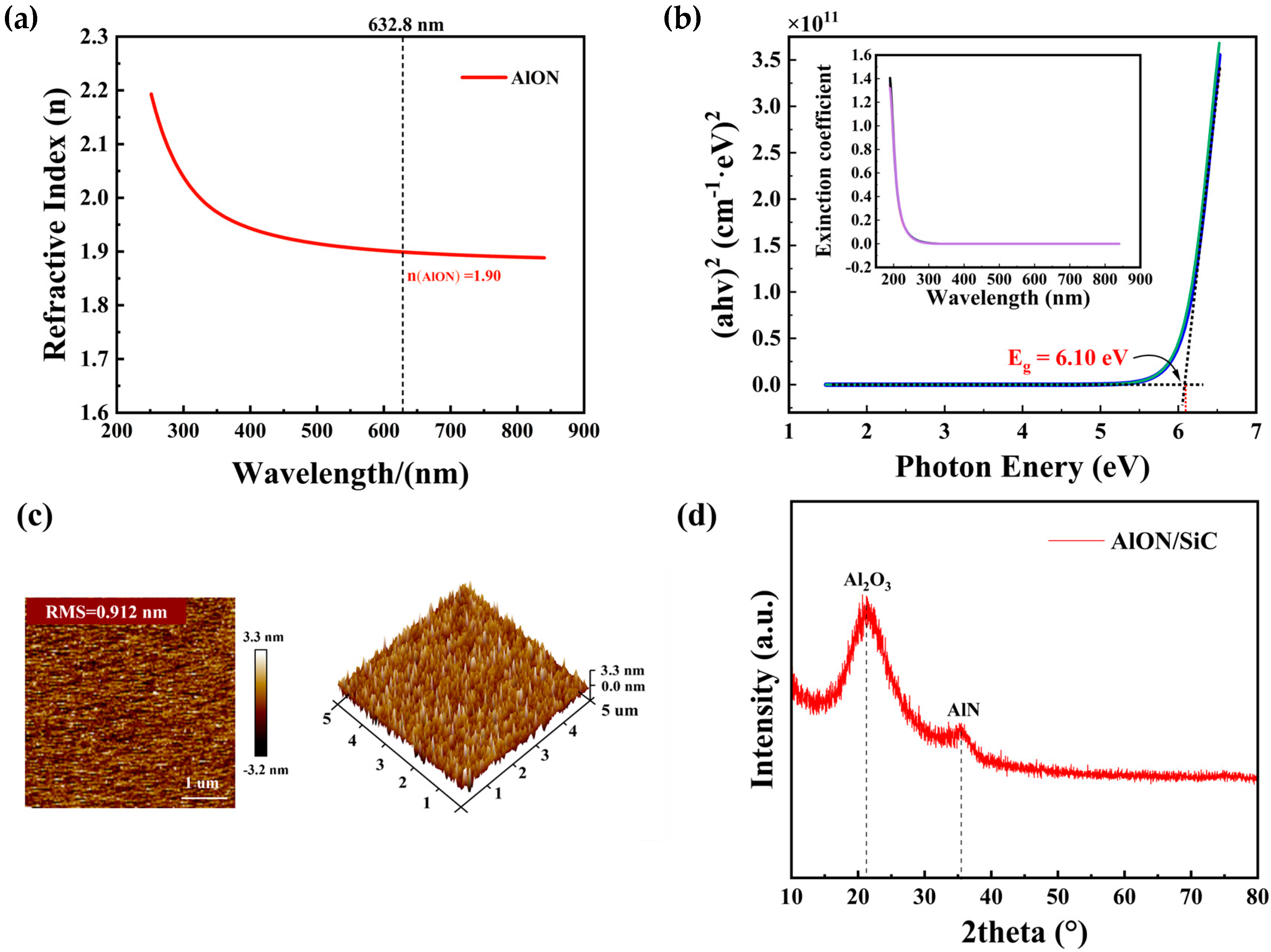
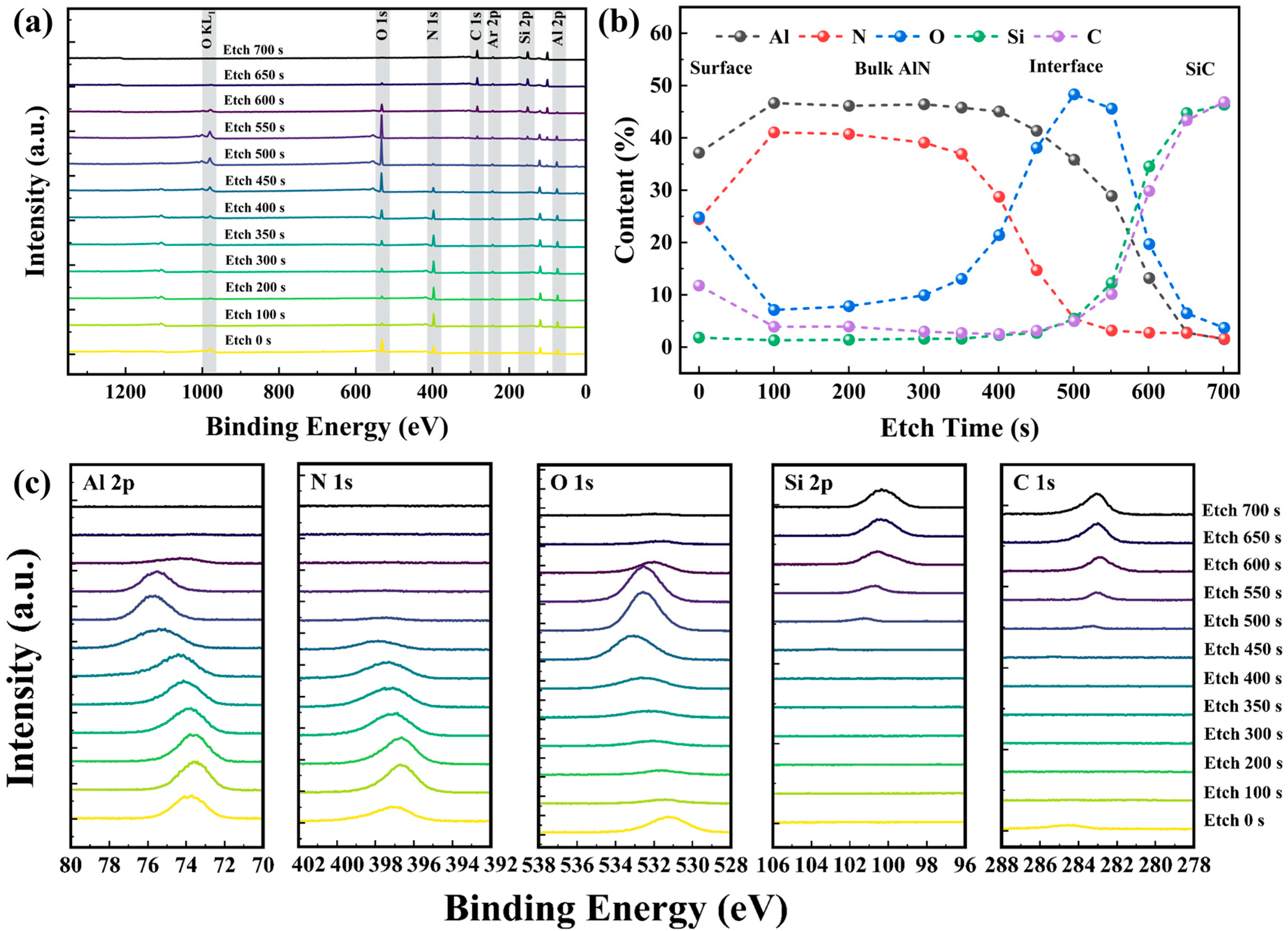

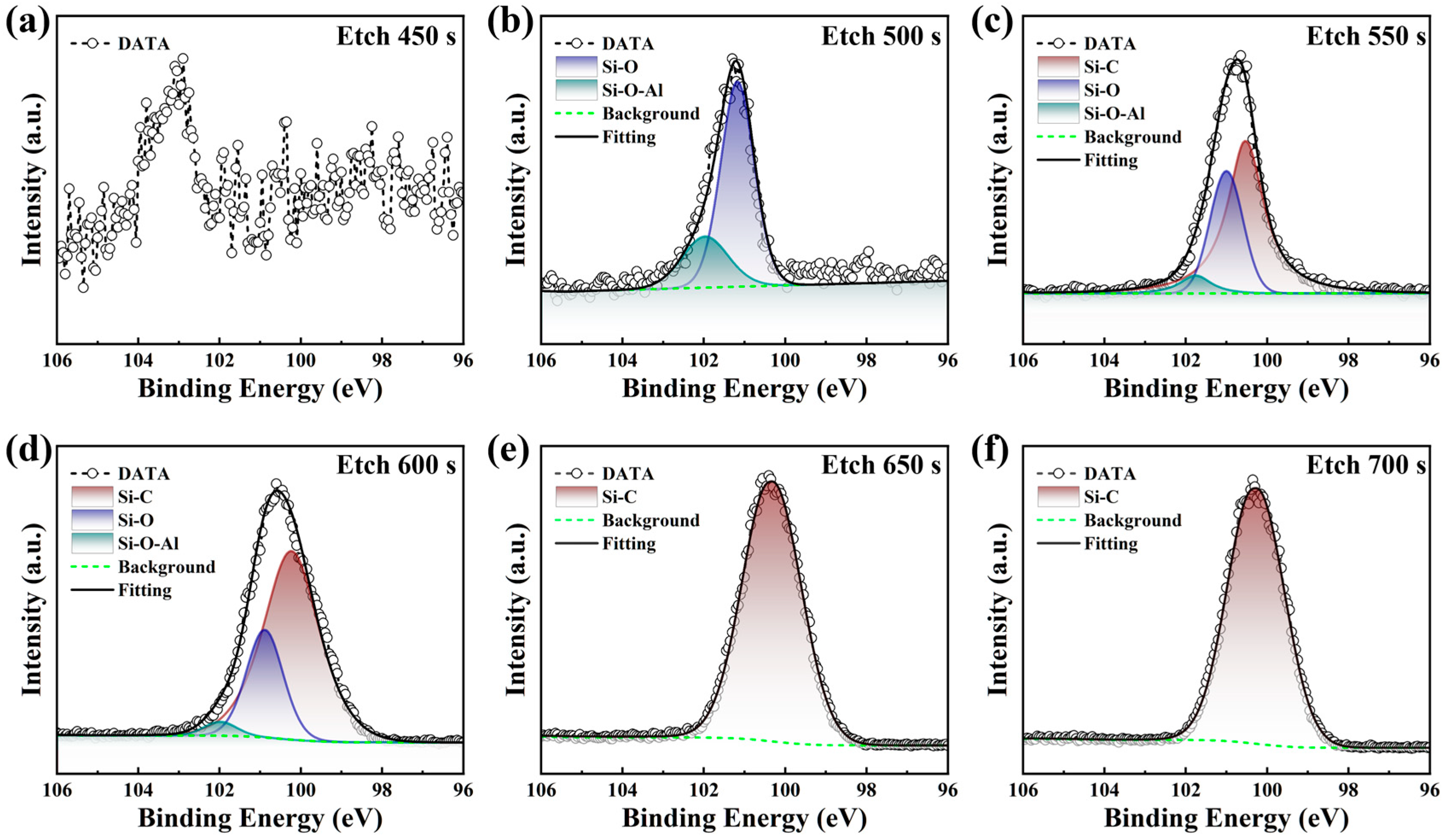
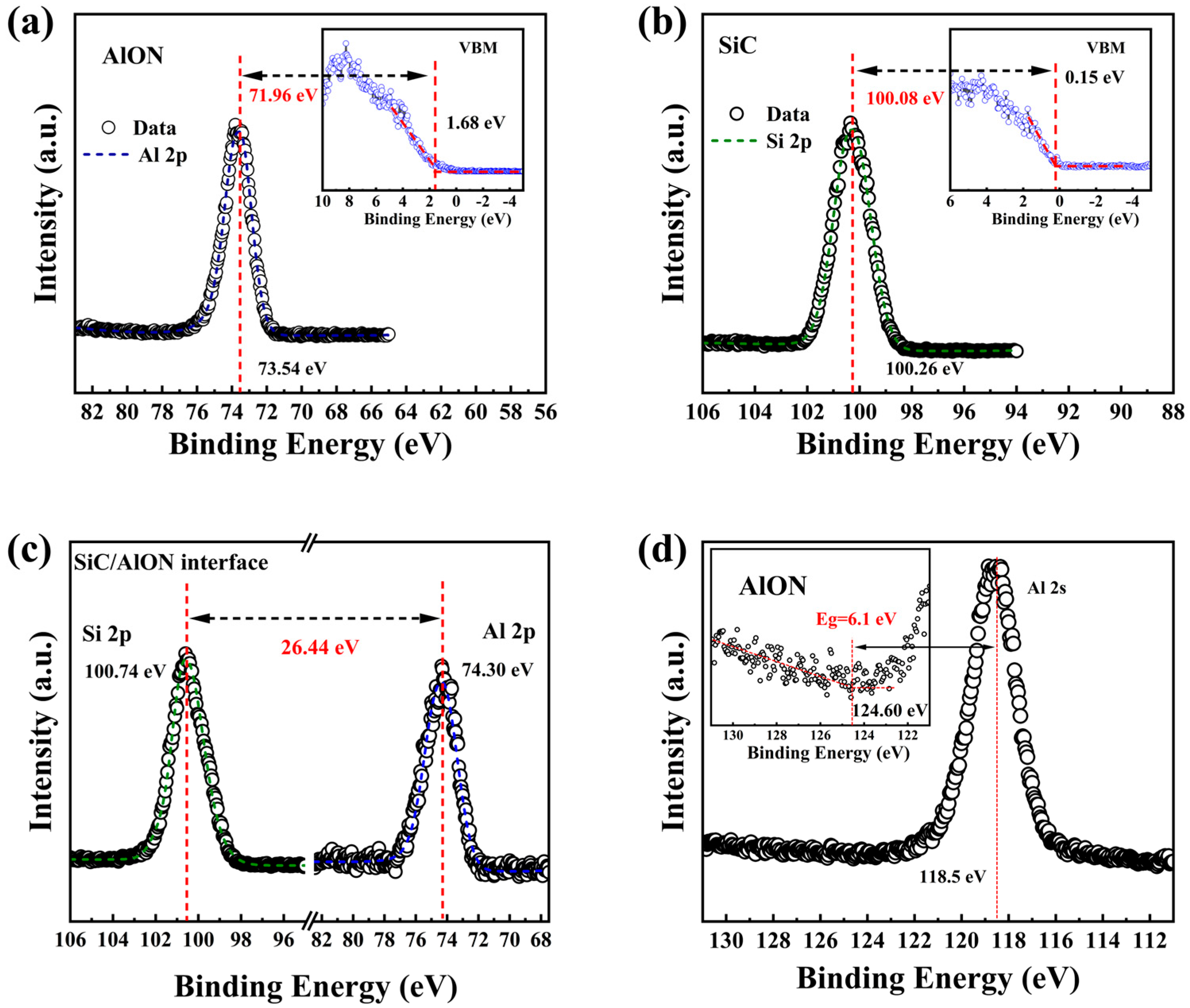
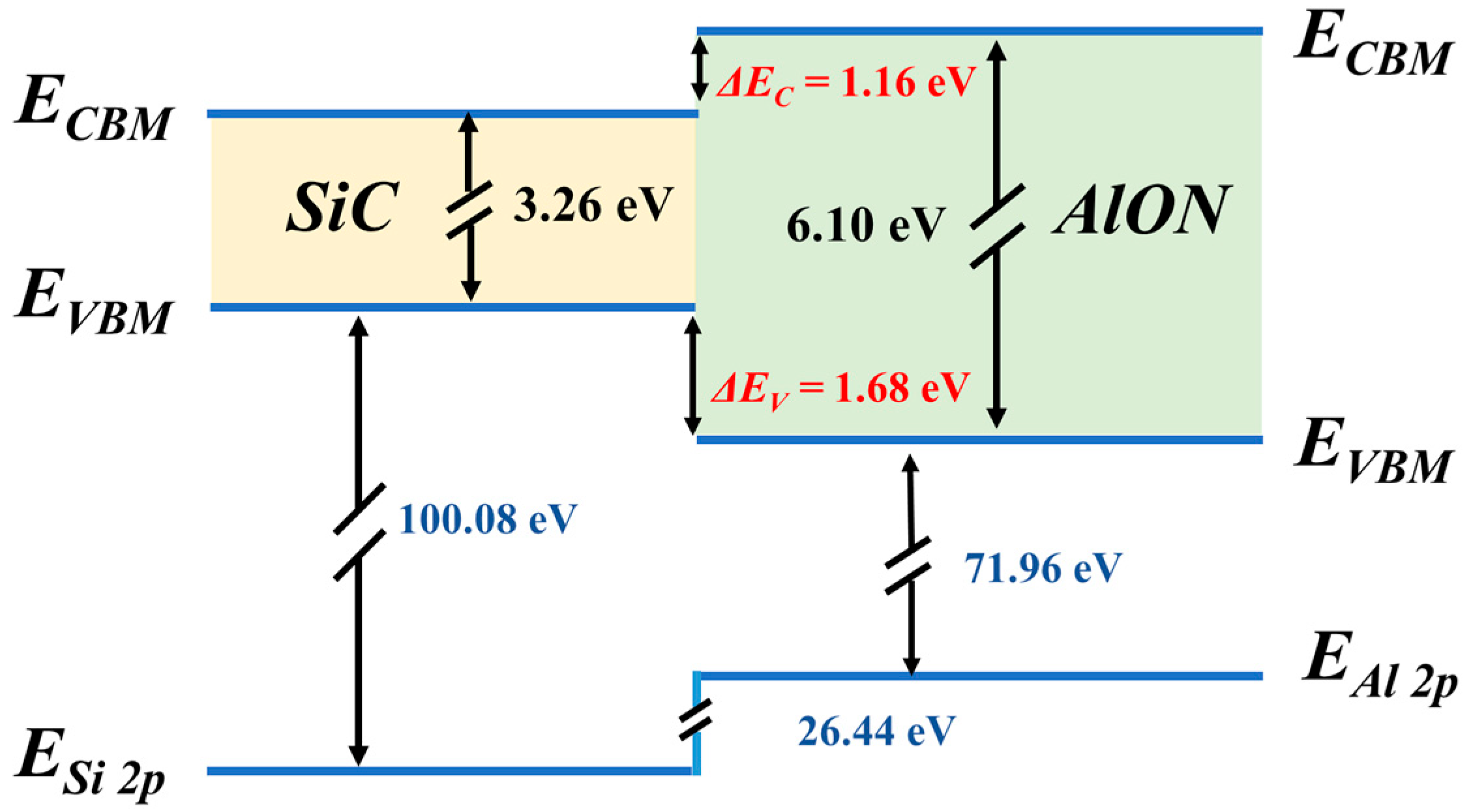
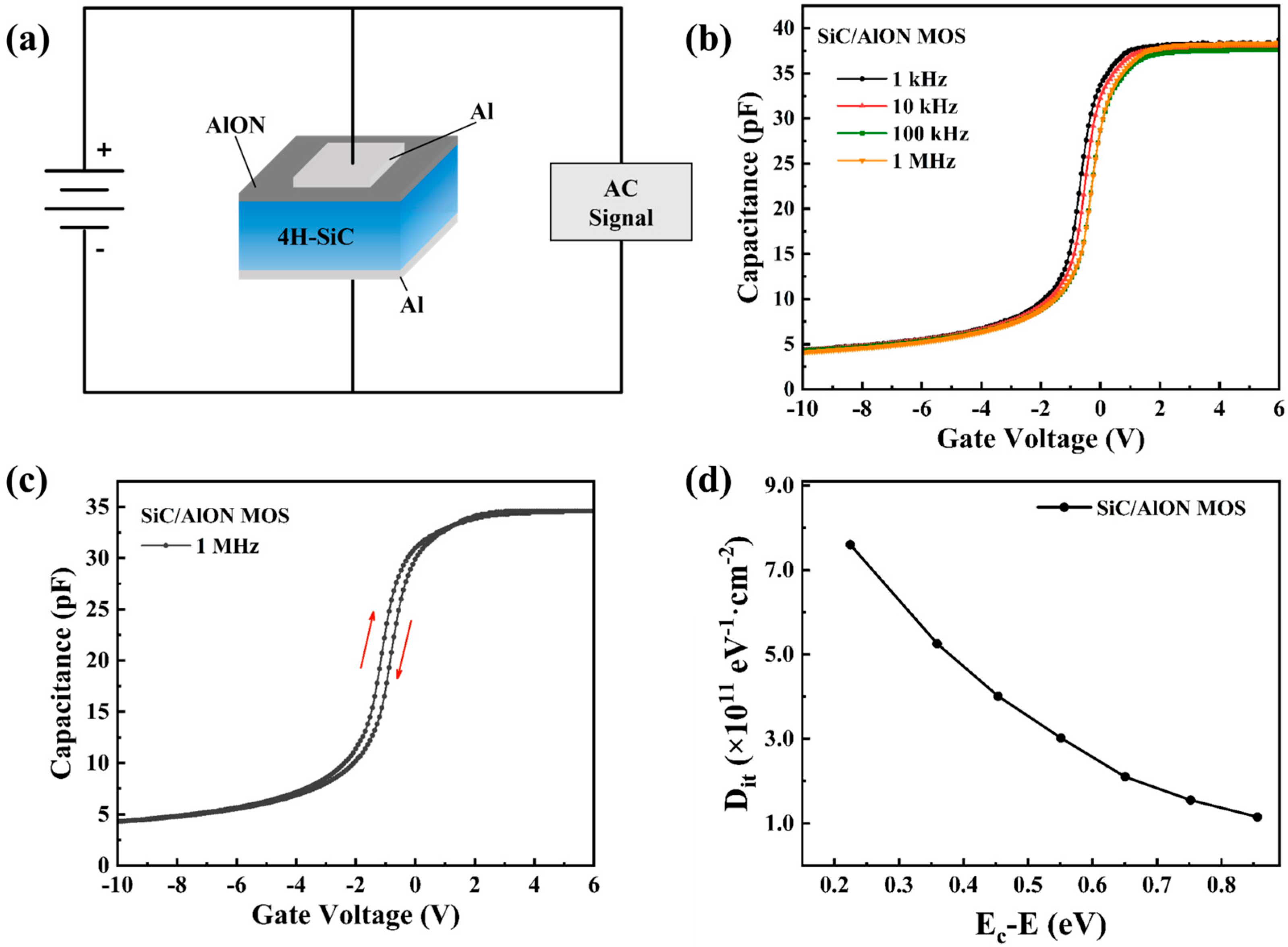
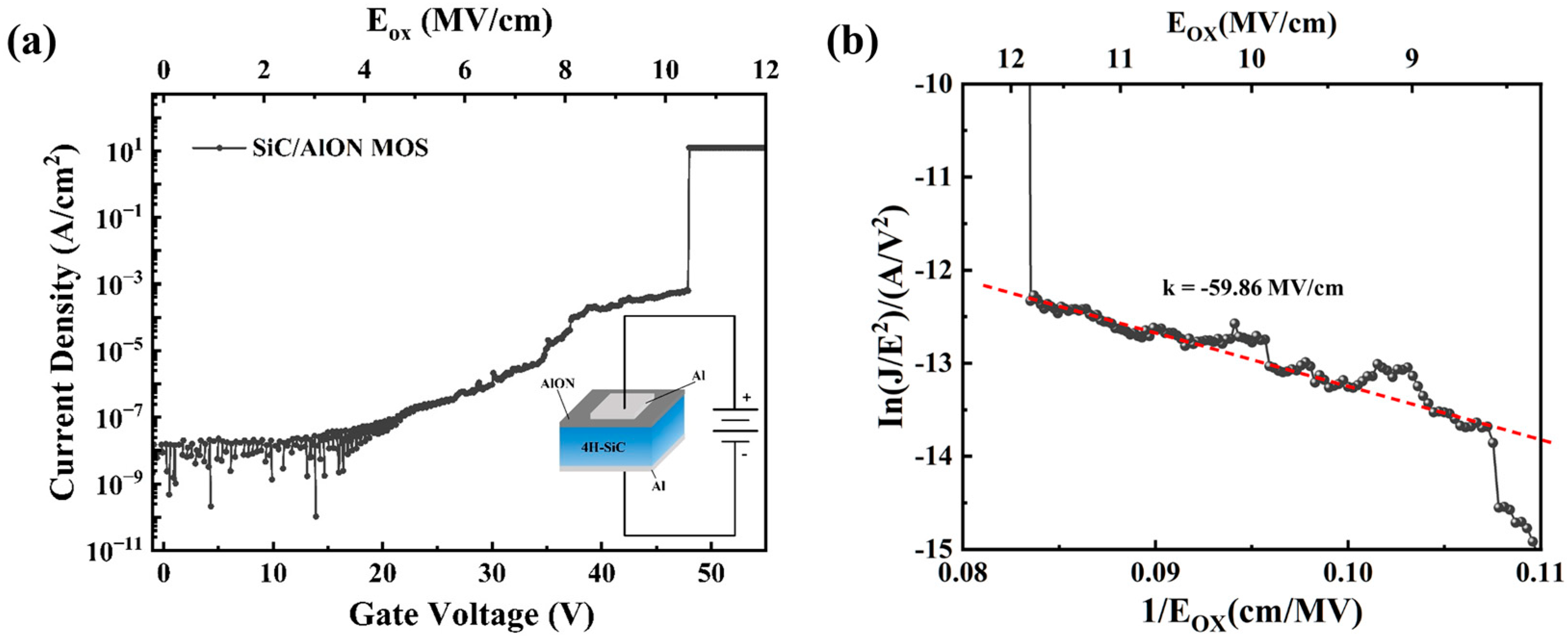
| Ideal VFB | Forward Bisa VFB | Reverse Bisa VFB | ΔVhy |
|---|---|---|---|
| 0.15 V | −0.48 V | −0.8 V | 0.32 V |
| Sample | Method | Dit at EC—0.2 eV | EBR | Reference | Time |
|---|---|---|---|---|---|
| Al/Al2O3/SiC | Hot plate at 200 °C | 1.2 × 1010 eV−1·cm−2 | 5.2 MV/cm | [9] | 2018 |
| Ti/Al/AlN/SiC | PEALD (TMA and NH3) | 1.85 × 1013 eV−1·cm−2 | — | [14] | 2024 |
| Al/AlN/SiC | PEALD at 200 °C (TMA and N2/H2) | 4.26 × 1012 eV−1·cm−2 | 10.9 MV/cm | [13] | 2020 |
| Al/AlON/SiC | PEALD at 200 °C (TMA and N2/H2/H2O) | 8.93 × 1012 eV−1·cm−2 | 11.4 MV/cm | [13] | 2020 |
| Al/AlON/SiC | PEALD at 200 °C (TMA and NH3/O2) | 7.6 × 1011 eV−1·cm−2 | 10.4 MV/cm | This work | 2025 |
| Sample | Method | Dit at EC—0.2 eV | EBR | Reference | Time |
|---|---|---|---|---|---|
| ZrO2/SiC | TALD at 270 °C (TDMAZ) | 1.58 × 1012 eV−1·cm−2 | 3.76 MV/cm | [48] | 2025 |
| ZrO2/SiC | TALD at 270 °C (TDMAZ and O2) | 9.5 × 1012 eV−1·cm−2 | 5.9 MV/cm | [49] | 2024 |
| HfO2/SiC | TALD at 250 °C (TEMAH and H2O) | 2.1 × 1013 eV−1·cm−2 | — | [50] | 2018 |
| HfO2/SiC | PEALD (TEMAH and O2) | — | 5.8 MV/cm | [51] | 2019 |
| Al/AlON/SiC | PEALD at 200 °C (TMA and NH3/O2) | 7.6 × 1011 eV−1·cm−2 | 10.4 MV/cm | This work | 2025 |
Disclaimer/Publisher’s Note: The statements, opinions and data contained in all publications are solely those of the individual author(s) and contributor(s) and not of MDPI and/or the editor(s). MDPI and/or the editor(s) disclaim responsibility for any injury to people or property resulting from any ideas, methods, instructions or products referred to in the content. |
© 2025 by the authors. Licensee MDPI, Basel, Switzerland. This article is an open access article distributed under the terms and conditions of the Creative Commons Attribution (CC BY) license (https://creativecommons.org/licenses/by/4.0/).
Share and Cite
Bai, Z.; Ding, C.; Guo, Y.; Luo, M.; Zhou, Z.; Gu, L.; Zhang, Q.; Ma, H. Improvement of Physical and Electrical Characteristics in 4H-SiC MOS Capacitors Using AlON Thin Films Fabricated via Plasma-Enhanced Atomic Layer Deposition. Materials 2025, 18, 4531. https://doi.org/10.3390/ma18194531
Bai Z, Ding C, Guo Y, Luo M, Zhou Z, Gu L, Zhang Q, Ma H. Improvement of Physical and Electrical Characteristics in 4H-SiC MOS Capacitors Using AlON Thin Films Fabricated via Plasma-Enhanced Atomic Layer Deposition. Materials. 2025; 18(19):4531. https://doi.org/10.3390/ma18194531
Chicago/Turabian StyleBai, Zhaopeng, Chengxi Ding, Yunduo Guo, Man Luo, Zimo Zhou, Lin Gu, Qingchun Zhang, and Hongping Ma. 2025. "Improvement of Physical and Electrical Characteristics in 4H-SiC MOS Capacitors Using AlON Thin Films Fabricated via Plasma-Enhanced Atomic Layer Deposition" Materials 18, no. 19: 4531. https://doi.org/10.3390/ma18194531
APA StyleBai, Z., Ding, C., Guo, Y., Luo, M., Zhou, Z., Gu, L., Zhang, Q., & Ma, H. (2025). Improvement of Physical and Electrical Characteristics in 4H-SiC MOS Capacitors Using AlON Thin Films Fabricated via Plasma-Enhanced Atomic Layer Deposition. Materials, 18(19), 4531. https://doi.org/10.3390/ma18194531








